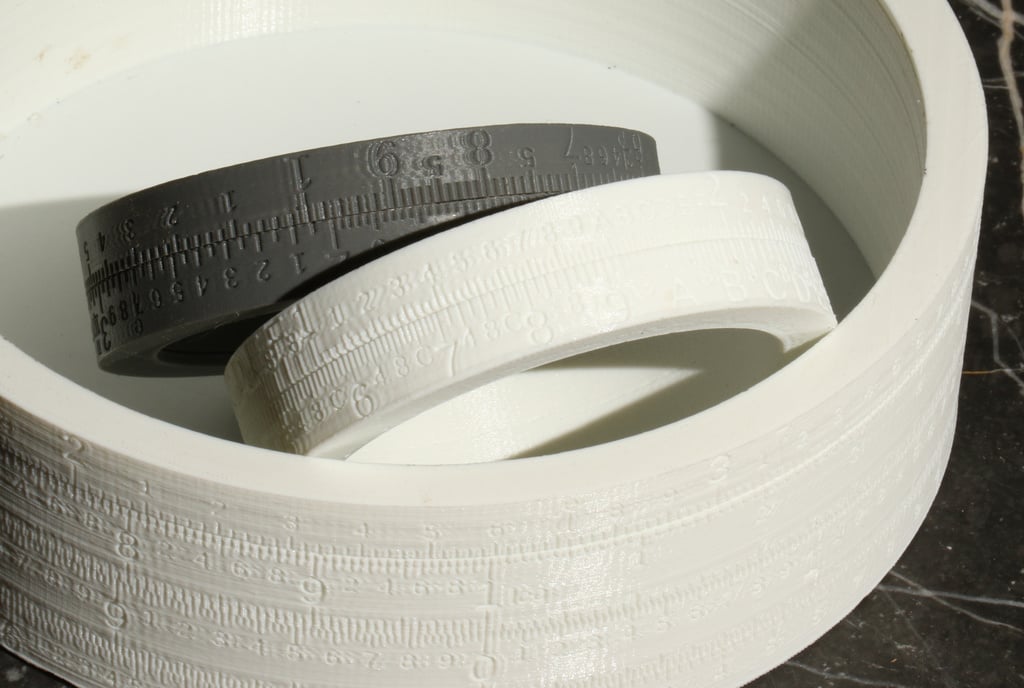
Ringed Slide Rule (with hexadecimal variant)
thingiverse
I made this after viewing the [rule wrist calculator: a circular slide rule](https://www.thingiverse.com/thing:4874992). I want 2 things: ------- - having Arabic numerals not dash and dots, - make it print in place. Hexadecimal version: --------------------- Of course, having a generator, making a hexadecimal version is a must and so it was done! Code quality: ---------- I'm still unsatisfied by my OpenSCAD code! Extended version: -------------- As you will discover in the code, I also made a extended version that give base 10 logarithm and the arcsin function. Usage: ======== - The 2 factors should be multiplied by a power of 10 so that it will be contain between 1 and 10, - Rotate so the first factor on first ring (you choice witch one you call first) will be in front of the 1 on the second ring, - Search on the second ring the second factor, - Read the number in front on the second factor on the first ring, - Correct the result by a power of 10. Note : I made the animated GIF to explain this process (it show how to multiply 7×7). Sadly the Thingiverse's tools destroy it when they made the preview and the small view so you'll have to enlarge it to see it clearly ! Educational advantage: =========== Order of magnitude: -------------------- As the device doesn't give the order of magnitude of the result, it force the user to estimate it himself. It mechanically train the user to think about the orders of magnitude that is a deficiency of many peoples in our times. Logarithm: ------------ Slide rules are an example of industrial application of logarithms before the electronic calculator become inexpensive. Numeration base: --------- Base 16 version (or others you decide to make) can shown that the calculus principles are independent of de base. Constants: ======== I introduce 4 constants into the classical version: - e: base of the natural logarithm = ~2.71828 - π: ratio of a circle's circumference to its diameter = ~3.14159 - ρ: ratio of a circle's circumference to its radius = 2×π - φ: golden ratio = (1+sqrt(5))/2 = ~1.618033 Fell free to make your own constant set. Material choice: ====== As you must see the relief, the filament used must be clear and opaque, opacity is more important than whiteness. For example, my grey print is easier to read than white ones ! The filaments than give me good results: blue: https://www.amazon.fr/gp/product/B073PB9QHV/ref=ppx_yo_dt_b_asin_title_o07_s00?ie=UTF8&th=1 grey: https://www.amazon.fr/gp/product/B07RJVHPBN/ref=ppx_yo_dt_b_asin_title_o00_s00?ie=UTF8&psc=1 A filaments that should be good cold white esun (don't confuse with there white one that is horrible): https://www.amazon.fr/eSUN-Pr%C3%A9cision-Dimensionnelle-Cartouche-Imprimante/dp/B07FQ98RNP/ref=sxts_rp_s1_0?__mk_fr_FR=%C3%85M%C3%85%C5%BD%C3%95%C3%91&cv_ct_cx=PLA+esun&dchild=1
With this file you will be able to print Ringed Slide Rule (with hexadecimal variant) with your 3D printer. Click on the button and save the file on your computer to work, edit or customize your design. You can also find more 3D designs for printers on Ringed Slide Rule (with hexadecimal variant).
